The Pixie Frog is sometimes called the Giant African Bullfrog and is native to southern Africa.
These giant frogs are one of the biggest in the world and can grow to be bigger than your hand. They also eat just about anything from small birds to baby snakes!
Pixie Frogs have become popular with hobbyists who want an aquatic and easy to care for pet that is more exciting than a goldfish.
They are very intriguing amphibians and spend most of their 20 year lifespan burrowed underground. Unlike most amphibians they only come out after heavy rainfall.
If this sounds like the frog for you then continue reading to learn more…
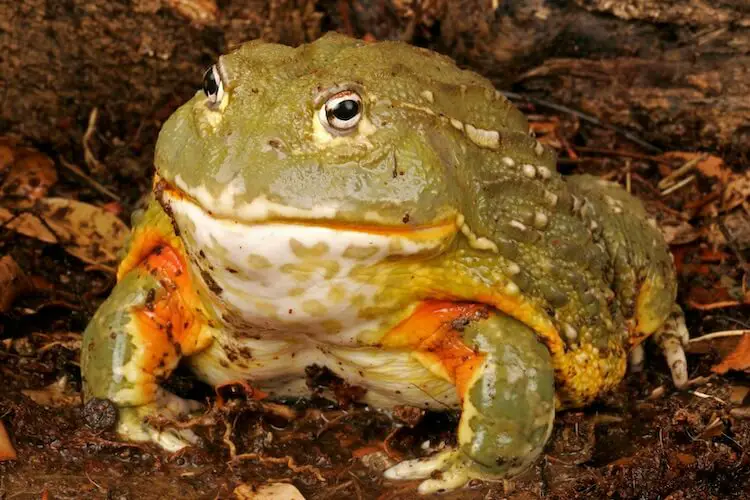
Pixie Frog Species Overview
Pixie Frogs are large olive-green frogs that can be found throughout southern Africa. They live anywhere from Gauteng in South Africa all the way north into Angola and Kenya.
The climate in this area is very arid with some subtropical grasslands.
Pixie Frogs spend most of their time burrowed underground in a cocoon made out of layers of their own skin. This is because of the heat in their natural habitat. They remain in a state of reduced activity (i.e. torpor) for most of the year and only come to the surface during periods of heavy rainfall.
It is only during periods of heavy rainfall they will mate.
They do not have an annual breeding season and are unique for their reproductive routine. The father frog is very involved in protecting the young tadpoles.
Pixie Frogs are one of the largest amphibians in the world and males can grow to over two pounds in size. Females are much smaller and weigh around one pound.
These large frogs are known by herpetologists for eating just about anything. They are mostly carnivorous with a diet consisting of mostly mice and other small animals such as lizards and baby snakes. On occasion they will eat plant material.
When kept as a pet they live best as the only frog in a tank.
They are generally inactive creatures and will spend their time sitting in a corner of the tank. Once or twice a week they can be social and may enjoy being held. They can live in a 20-gallon aquarium with warm temperatures and extremely high humidity. A terrarium will work if you can maintain high humidity.
Typical Behavior
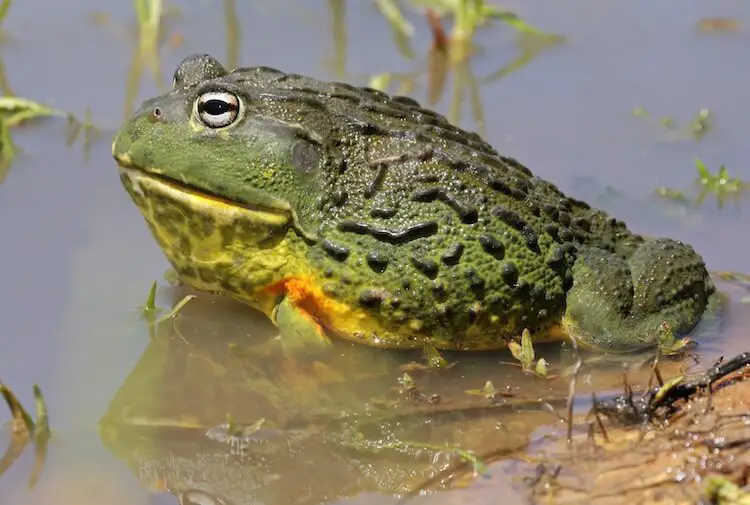
In the wild Pixie Frogs have very interesting behaviors.
They are nocturnal so are only active at night and do not travel far from their breeding spots. They will only come to the surface after heavy rainfall.
This species of frog is extremely aggressive, territorial and will rarely submit to their opponents. Males will often fight over mates during times of breeding.
Due to their aggressive nature you should never house two together. Males often fight with each other, even without the presence of a female.
They show aggression by:
- Making a snorting sound that can sometimes sound like a whistle if it is underwater.
- Jumping towards each other with mouths wide open.
- Throw their adversary into the air onto its back.
- Grabbing the opponent by the hind legs.
South African Burrowing Bullfrog
In the wild Pixie Frogs spend most of their burrowed underground in a state of reduced activity (i.e. torpor). They burrow into the soil using their hind legs and form a cocoon of layers of shed skin which cover the whole body except for their nostrils (i.e. external nares).
They are relatively inactive in a tank and may rest with their eyes open for most of their time.
To avoid your frog going into torpor keep them well-fed and hydrated. They will revert to their dormant state if you withhold food and water from them.
Is A Pixie Frog Poisonous?
African Pixie Frogs are not poisonous, however some can be aggressive and deliver a nasty bite. You should be careful when handling a hostile frog as they are going to be very eager to jump.
If they have been with their owner from a very young age some are social and tolerate handling.
They are a great pet for beginners who want to learn how to care for a frog but not frequently hold them.
Washing your hands before and after handling is a must as they have been shown to carry Brucella bacteria.
Species Appearance
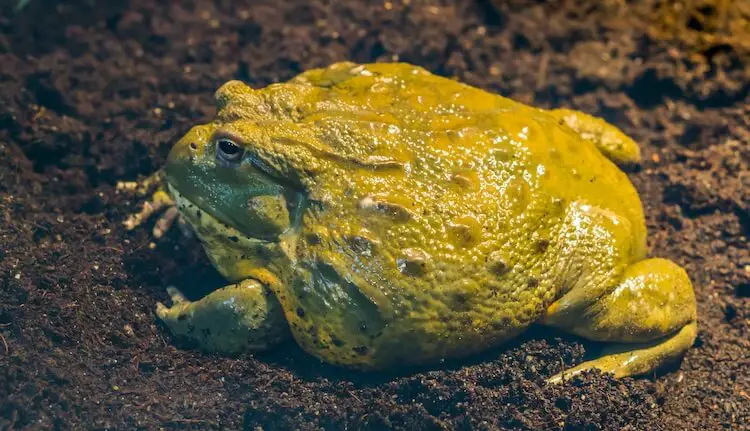
Pixie Frogs are heavy built frogs.
They have large heads and mouths and are much larger than a common pond frog.
Because they are not pond frogs they have little to no webbing on their feet. Instead their inner toes on the hind legs have a sharp callus used for digging.
Pixie Frogs do not vary much in color and are usually olive green with yellow or cream coloring on their throats.
Males have bright yellow throats and females’ throats are cream-colored.
Giant Pixie Frog
Males will grow as heavy as two to three pounds and are nine inches long. Females are half the length of males and weigh one pound.
There is a clear difference between males and females as males can be up to ten times as large.
Tadpoles are a couple of inches long and will be fully grown by the time they are two years old.
Pixie Frog Care Sheet
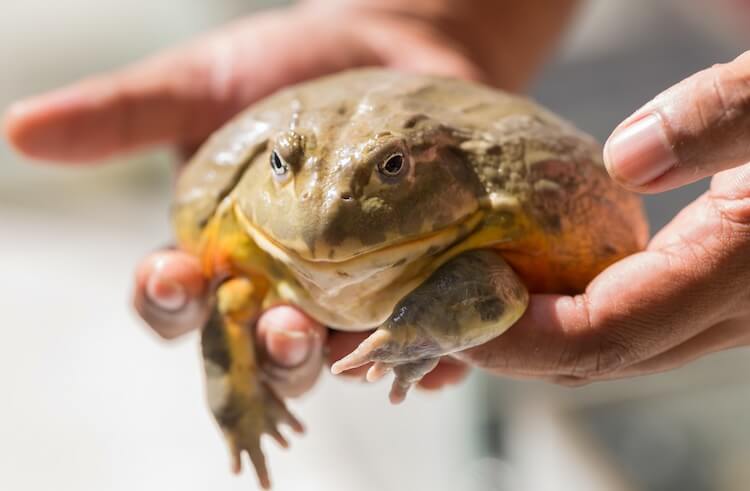
These frogs provide an excellent learning opportunity and can teach you a lot about taking care of a large amphibian.
What We Like About Pet Pixie Frogs
Pros
- Their diet is very easy as they eat just about anything.
- They are very inactive and do not need a large terrarium.
- They can be very sociable if they are handled from a young age.
Cons
- They can be very aggressive and territorial so must be kept alone.
- Their aquarium should be kept very humid.
- Difficult for beginners to handle if they are purchased as an adult.
Pixie Frog Diet
Pixie Frogs are omnivores and will eat animals that are almost the same size as them. They will only eat plants if they are hungry. They are a sit and wait predator that eats every couple of days.
They will eat any food that comes their way:
- Rats
- Lizards
- Other frogs
- Small birds
- Baby snakes
They are not picky and will rarely reject food.
Adults should be fed two or three times a week with occasional snacks. Food should always be fed with forceps to avoid getting your finger bitten.
There isn’t a commercial feed available for adult Pixie Frogs so they should be fed several gut-loaded insects or a freshly thawed pinky mouse. Some owners feed Purina trout chow.
Juveniles should eat the same diet as adults but every day.
Leftover food should be spot-cleaned within two hours of feeding.
Tadpoles mostly eat aquatic plants, insects and algae. You can feed a commercial tadpole diet.
Your Bullfrog should always have access to a large bowl of drinking water and separate bathing and sloughing bowl. Both bowls should be changed daily.
Pixie Frog Lifespan & Health
Pixie Frogs can live long and healthy lives when they receive correct husbandry. Their typical lifespan is 20 years, but some have been recorded to have lived for 45 years.
Their most common health problem is obesity because they are always eager to eat. It is essential that you feed them based on a diet plan or schedule.
You should track their weight and body condition to plan their food intake. Your frog should grow until they are two years old and then their weight should be relatively consistent.
Another health problem that may occur in this species is internal parasites.
Parasites can easily be avoided by keeping their enclosure warm. If your frog is disinterested in eating this could be a sign of parasites, fungal or bacterial infections.
Frog feces are usually very large and dark brown. There may be an underlying health problem if your frog is not defecating or if the feces looks abnormal.
Signs They Are Healthy
- Eager to eat.
- Consistent weight.
- Skin looks normal and feels soft.
Sickness Symptoms
- Disinterested in food.
- Abnormal weight gain.
- Dry and shriveled skin.
Enclosure
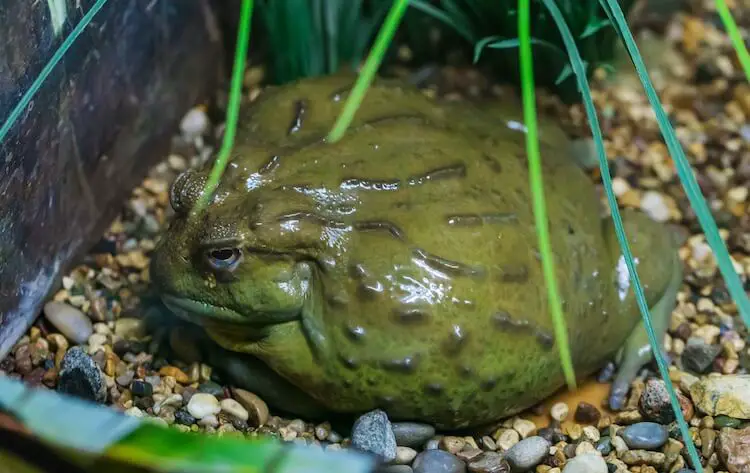
Pixie Frogs live in dry arid environments and spend most of the year buried underground.
They come out of their hiding spaces only after heavy rainfall which is uncommon and sometimes occurs just once a year in Southern Africa.
This species likes heavy rain and their environment in captivity should reflect this.
Adult tanks should be set up for a terrestrial animal that also needs water to soak in.
Cage & Set Up
Pixie Frogs do not need a large enclosure and should live in a 20-gallon tank. Because they are semi-aquatic they live very well in aquariums.
In an adult tank you should include stones, large rocks and driftwood.
They do not need a basking spot or hiding places.
Aside from their drinking bowl, they should have a large bathing bowl with water about an inch or two deep. This bowl keeps humidity high and serves as a place for them to bathe and defecate.
- Tank Type: glass aquarium.
- Tank Size: 20-gallon.
- Lighting: low wattage fluorescent bulb.
- Substrate: layers of leaves.
Lighting their tank is very simple because Pixie Frogs do not require UVB light. You can use a simple low wattage fluorescent bulb.
Their tank should be kept above room temperature at 75℉ by using an under tank heater.
Humidity should be kept at between 70% to 80% and should be controlled by misting the tank daily and by filling up the bathing bowl every day. You should keep a humidity gauge in the tank.
It is best to use a substrate for your Pixie Frog that can get wet. Suitable substrates include:
- Moss.
- Reptile bark.
- Layers of leaves.
- Synthetic foam.
Stay away from loose substrates (sand or gravel) and paper towels or newspaper as they absorb too much water.
Spot cleaning of waste, substrate and food should be done every day and the water bowls should be changed daily too. The tank should be fully emptied and cleaned with a diluted bleach solution and warm water once a week.
Baby Pixie Frog
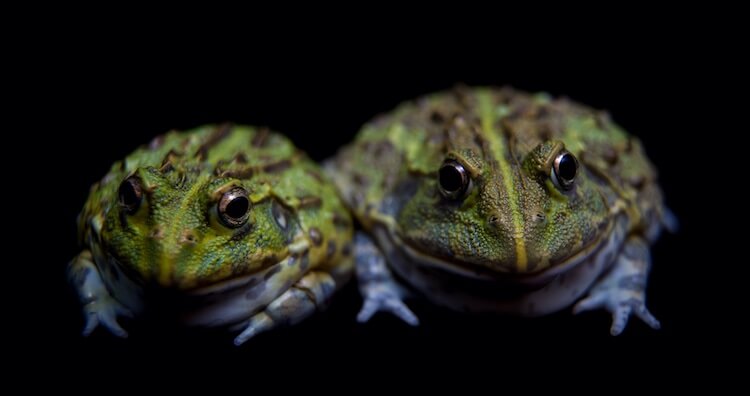
Pixie Frogs only come out to mate when there is heavy rainfall.
Once every four years up to 60 males will gather in ponds or puddles with the more dominant males residing towards the middle.
They attract a female’s attention by emitting a low-pitched whoop that lasts for a couple of seconds.
Courtship happens at night between 7pm and 11pm and females can lay 4,000 eggs per clutch.
Their eggs are not sticky and are spread into a thin layer into the water. They will hatch 48 hours later.
Males are heavily involved in protecting tadpoles because they are larger and stronger than females. They also dig channels for tadpoles trapped in drying puddles.
How Much Does A Pixie Frog Cost?
Juveniles cost $25 – $75 depending on the breeder you choose. It is best to purchase from a breeder and not a pet store that sells wild-caught frogs because they are slowly disappearing from the wild.
Many breeders raise tadpoles until they are juveniles and then sell them.
You should look for a frog that has green skin without abnormal bumps or lesions and clear eyes.
Housing Tadpoles and Juveniles
Tadpoles are two inches long and can be kept in their adult 20-gallon tank that is filled with water.
Metamorphosis occurs after 20 days.
When your tadpoles start metamorphizing into juveniles they should have several inches of water to swim in. They also need a rock or log that they can easily climb onto.
Juveniles should eat everyday rather than every couple of days, but their diet and husbandry requirements remain the same.
| Common Name | Giant Pixie Frog |
|---|---|
| Scientific Name | Pyxicephalus adspersus |
| Price | $25 to $75 |
| Size | 9 inches |
| Lifespan | 20 to 45 years |
| Diet | Gut-loaded insects and pinky mice |
| Tank Size | 20-gallon |
| Humidity & Temperature | Daytime temperature: 75℉ Humidity: 70% – 80% |
| Popular Alternatives | Pacman Frog, Leopard Frog, White’s Tree Frog |
Summary
Pixie Frogs are incredibly unique pets that have rapidly gained popularity for being easy to care for.
They make great beginner frogs for anyone who wants a unique and large amphibian that eats almost anything you feed it.
Pacman frogs or White’s Tree Frogs are good alternatives for someone who wants a more social and smaller frog that tolerates handling better.
If the Pixie Frog sounds like the frog for you then starting preparing to bring home a very large pet reptile and let us know in the comment section.







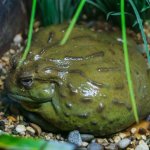
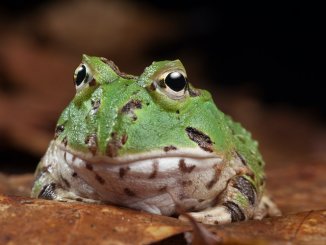
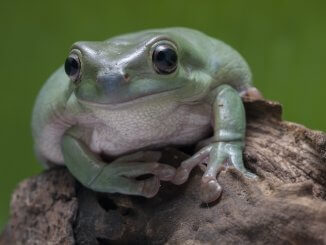
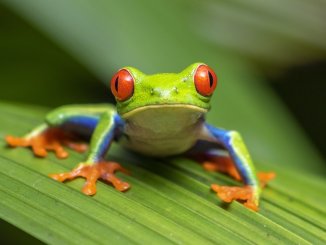

I just adopted a baby pixie frog! I’m so excited. I have been feeding him mealworms and small crickets in the few days I’ve had him, and he’s always very eager to eat – it’s fun to watch! I already love this little guy. He’s in a 10 gallon tank right now, but once he grows I will definitely upgrade to at least a 20 gallon, if not larger. Let me know if anyone has any tips for keeping these guys healthy & happy! I have quite a few other reptiles too, so this isn’t my first go-round (I have 3 tortoises, 3 leopard geckos, 2 chameleons, and a bearded dragon too). I’m super excited to finally have a frog!!